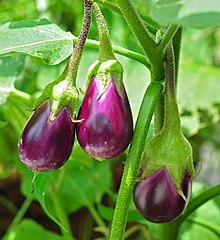**Botanical Information and Cultivation:**
– Eggplant is a plant species in the nightshade family Solanaceae, related to tomato, chili pepper, and potato.
– It is grown worldwide for its edible fruit, typically purple, spongy, and absorbent.
– Eggplant is a tropical perennial plant grown as an annual in temperate climates, reaching 40 to 150cm tall.
– The fruit is botanically classified as a berry with 12 chromosomes in its genome.
– Eggplant oxidizes quickly when cut open and is known for absorbing oils and flavors during cooking.
– Seeds are sown in tropical and subtropical climates, typically 8-10 weeks before the frost-free date.
**Production and Cultivars:**
– In 2021, global eggplant production was 59 million tonnes, with China and India contributing 86% of the total.
– Different varieties of eggplants are cultivated for diverse shapes, sizes, and colors.
– Common cultivars include elongated ovoid dark purple types, white varieties, and Indian and Asian cultivars with various shapes and colors.
– Genetically engineered Bt brinjal for insect resistance has been developed, with commercial cultivation in Bangladesh.
– Eggplant is a significant crop globally for its culinary uses and versatility in various cuisines.
**Culinary Uses and Nutrition:**
– Eggplant is used in various cuisines worldwide and can serve as a meat substitute in vegan dishes.
– Preparation methods include steaming, frying, roasting, and pickling.
– Nutrient content per 100g includes 25kcal energy, 5.88g carbohydrates, 3g fiber, and vitamins B1, B2, B3, B5, B6, B9, C, E, and K.
– It also contains minerals like calcium, iron, magnesium, manganese, phosphorus, potassium, and zinc.
– Different regions have specific culinary uses, such as deep-fried eggplants in Chinese cuisine and pickled stuffed eggplants in Levantine dishes.
**History, Etymology, and Taxonomy:**
– Eggplant’s origin is debated, with mentions in Indian, African, and South Asian regions.
– First written record dates back to a Chinese agricultural treatise from 544 CE, with introductions to Spain by Arabs in the 8th century.
– The plant has various English names like eggplant, aubergine, and garden eggs with origins in Arabic and Portuguese.
– Taxonomically, eggplant has been confused with other species like scarlet and Ethiopian eggplants, with various invalid names historically applied.
– It has a long history of consumption and cultivation, with cultural significance in various cuisines worldwide.
**Chemistry, Allergies, and Additional Information:**
– Purple skin color is due to anthocyanin nasunin, while browning of flesh is caused by polyphenol oxidation.
– Some individuals may experience mild allergic reactions like itchy skin or mouth after handling or eating eggplant.
– Eggplant is featured in scientific literature under various synonyms like S. ovigerum and S. trongum.
– Historical records show eggplant consumption in medieval cookbooks and literature, with roots in Arabic etymology.
– Eggplant’s names have evolved over time in different languages and regions, reflecting its culinary and cultural significance.
Eggplant (US, CA, AU, NZ, PH), aubergine (UK, IE), brinjal (IN, SG, MY, ZA), or baigan (GY) is a plant species in the nightshade family Solanaceae. Solanum melongena is grown worldwide for its edible fruit.
| Eggplant | |
|---|---|

| |
| The fruit developing on the plant | |
| Scientific classification | |
| Kingdom: | Plantae |
| Clade: | Tracheophytes |
| Clade: | Angiosperms |
| Clade: | Eudicots |
| Clade: | Asterids |
| Order: | Solanales |
| Family: | Solanaceae |
| Genus: | Solanum |
| Species: | S. melongena
|
| Binomial name | |
| Solanum melongena | |
| Synonyms | |
|
Solanum ovigerum Dunal | |
Most commonly purple, the spongy, absorbent fruit is used in several cuisines. Typically used as a vegetable in cooking, it is a berry by botanical definition. As a member of the genus Solanum, it is related to the tomato, chili pepper, and potato, although those are of the New World while the eggplant is of the Old World. Like the tomato, its skin and seeds can be eaten, but, like the potato, it is usually eaten cooked. Eggplant is nutritionally low in macronutrient and micronutrient content, but the capability of the fruit to absorb oils and flavors into its flesh through cooking expands its use in the culinary arts.
It was originally domesticated from the wild nightshade species thorn or bitter apple, S. incanum, probably with two independent domestications: one in South Asia, and one in East Asia. In 2021, world production of eggplants was 59 million tonnes, with China and India combined accounting for 86% of the total.
